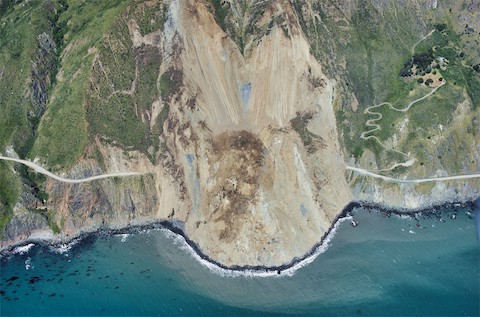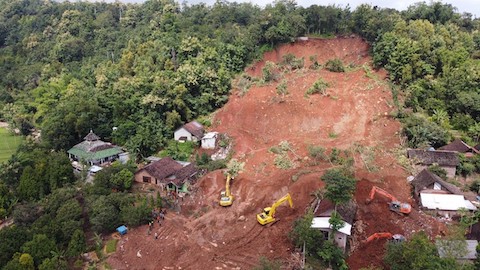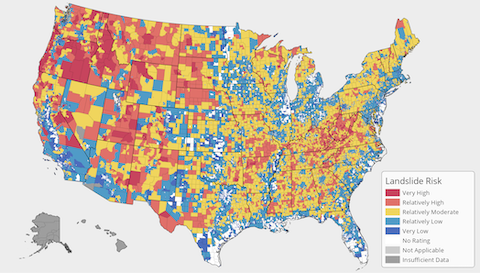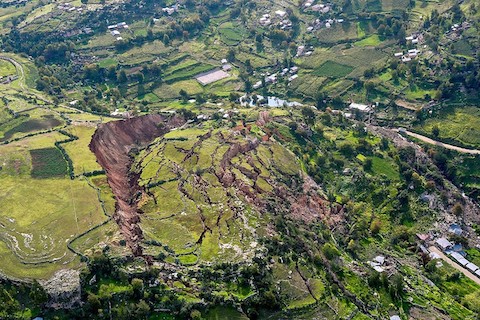
Landslides happen when a slope becomes unstable—because of denuding, from a fire or deforestation; over-steepening, from erosion or mining; overloading, from a reservoir or heavy snowpack; or oversaturation, with rain or melt water.
So many things can cause a landslide that they happen in every U.S. state and nearly every country.
When the slope gives way, soil can speed downhill at 50 to 100 miles an hour, carrying trees, boulders, cars, even houses.
Earthquakes trigger just five percent of landslides. Twenty percent are caused by human activities, while three-quarters come from precipitation.
Though some landslides happen suddenly, most give warning signs: cracks in pavement or soil, earth bulging at the base of a slope, water springs in new places.
Your chances of getting caught in a slide are remote. But if you live in a landslide-prone area, keep these things in mind:
Risk comes from uphill. You may want to move bedrooms or living areas to the downhill side of the house.
If you suspect a slide is coming, open downhill windows and doors to allow debris that could pass through the house to exit.
To escape a landslide, go up! Upstairs, and up on top of furniture, to have the best chance to stay on top of the debris.
In the very unlikely event you’re trapped, never give up. Make noise so rescue teams can find you.
Background
Synopsis: Globally, 2000–3000 people die in 400–500 landslides each year that cause billions of dollars of damage. Deaths typically occur by blunt trauma or entrapment that causes suffocation. Six simple practices have saved lives in the past, and they can save yours too!
- Landslides are gravity-driven events that include sediment and rocks that slide or flow downhill in a water or mud slurry.
- They may incorporate trees, buildings and cars, or anything in their path.

- They occur in areas of slope instability that can be caused by denuding (fire or deforestation), oversteepening (erosion, construction or mining), loading (reservoirs, snow accumulation or landfills), or increasing water saturation (heavy rainfall, snowmelt or flooding) in the earth materials that make up the terrain.
- When a slope becomes unstable, earth movement can be triggered by events like earthquakes, thunderclaps, or vibrations from vehicles.
- Once in motion, debris can move at up to 55–100 mph (90–160 km/h).
- In a previous EarthDate episode (ED-023), we talked about how landslides form and the tragic consequences of the 2014 Oso Landslide in Washington State.
- Surprisingly, only about 5% of landslides are caused by earthquakes each year.
- More than 75% are caused by precipitation while the remainder are caused by human activities like construction and mining.
- With rising temperatures, melting snow, ice and permafrost may result in more frequent landslides.
- Landslides are most common near changes in slope, flatter areas away from slope breaks are safer.
- Landslides occur in every U.S. state and territory.

- Many times, landslides provide early warning signs on slopes.
- Cracks in slopes.
- New seeps or springs that appear in previously dry areas.
- Cracks, bulges or depressions in the ground, roads or pavement.
- Soil separating from foundations.
- Broken water lines or leaning telephone poles.
- Offset fence lines.
- Trees and boulders cracking together.
- Over the past few decades, scientists noticed that certain behaviors by a small number of people in an at risk community increased their chances of survival. In 2020, researchers evaluated and shared six beneficial practices that have saved lives.
- Know your risk! Increase your awareness of potential hazards near your home or office by contacting your local geological survey or university. Create an emergency plan. Learn to watch for landslide warning signs and stay especially vigilant during flooding events. If you suspect a landslide is imminent, call your local emergency officials, inform neighbors, and evacuate in a direction lateral to the area of concern.
- Know where the risk will come from! Move high occupancy rooms like bedrooms to less dangerous locations upstairs or on the downhill side of the building. Move beds away from uphill exterior walls. In the event you need to shelter, do so in a room as far as possible from the direction of the landslide’s approach.
- Go up! Escape vertically upstairs or onto countertops or flat tops of furniture or beds, (opposite of tornado strategy). Don’t try to shelter behind heavy furniture; it can kill you by blunt force trauma. Get on top of it.
- Find sturdy rooms! Similar to tornado survival, escape to a small, unfurnished room like a closet or bedroom that offers more support with denser structural elements like walls and doorframes.
- Open up downhill! Open downhill doors and break windows before debris enters your home, being careful not to get swept into the flow. Don’t open uphill doors if you hear the flow coming.
- Don’t give up! If trapped by a landslide, continue to make noise or movement to help rescue teams find you. Poke a stick upward and wiggle it.
- After a landslide, stay away from the slide area which could reactivate for days or weeks after the event, but listen for local news and help rescue crews and neighbors if you can do so safely.


